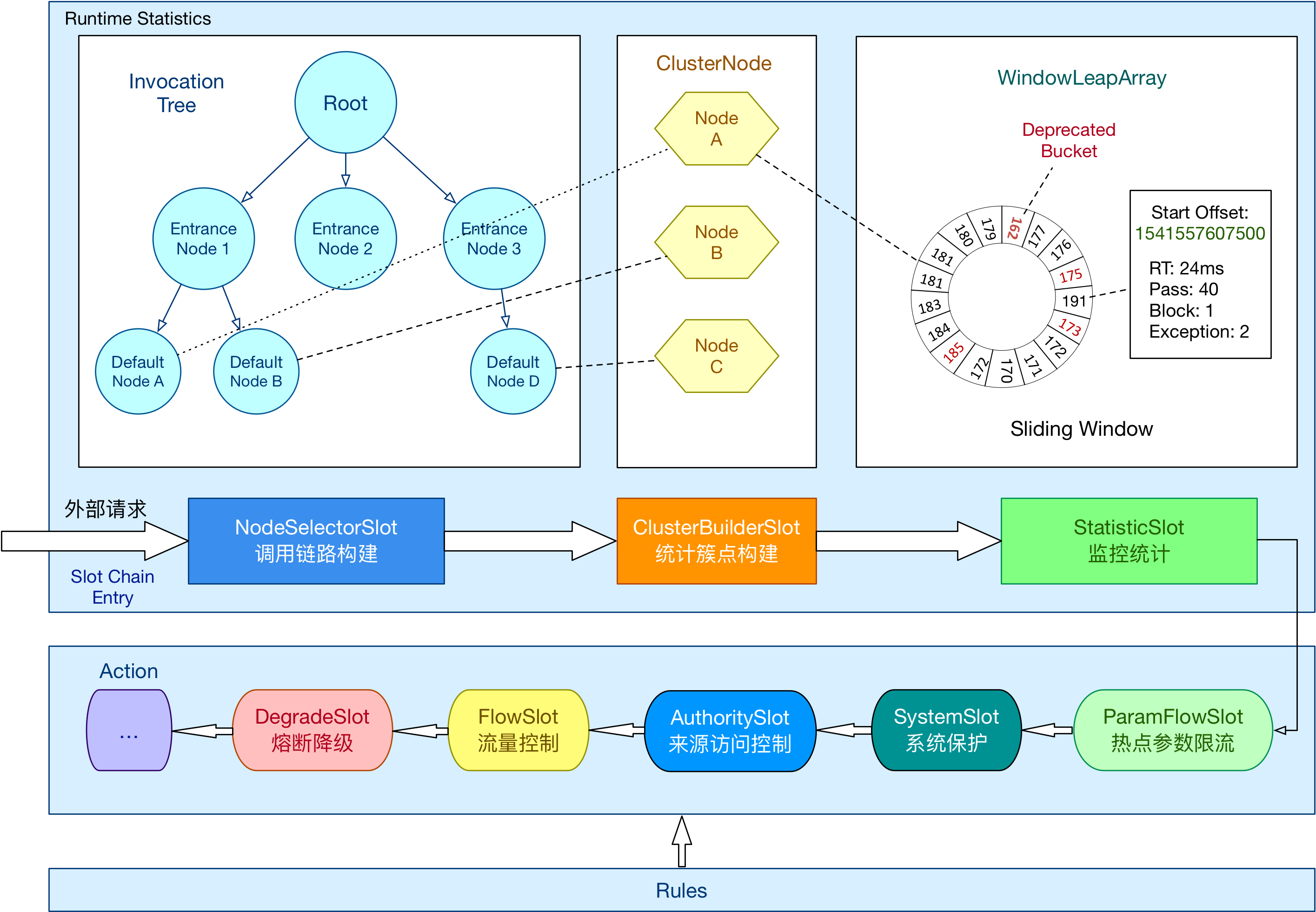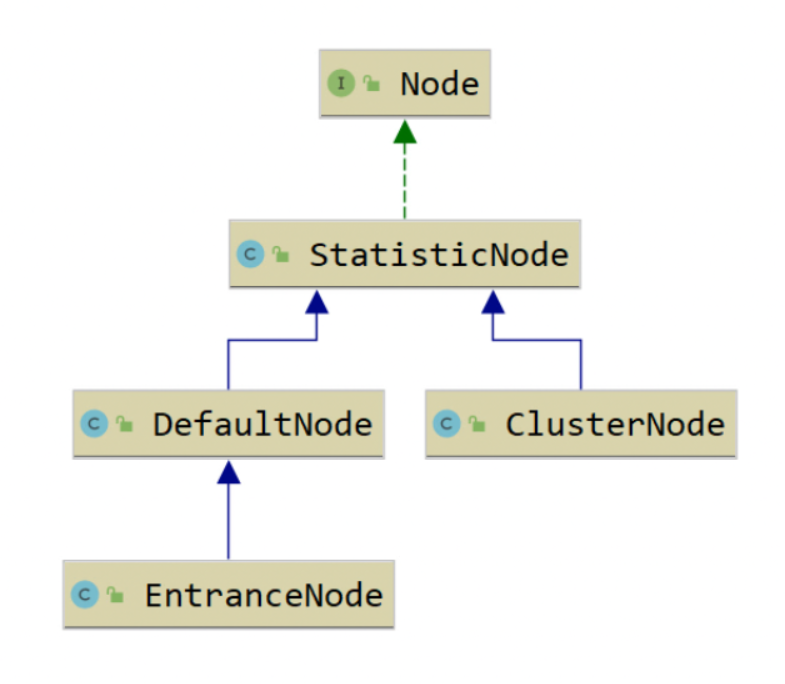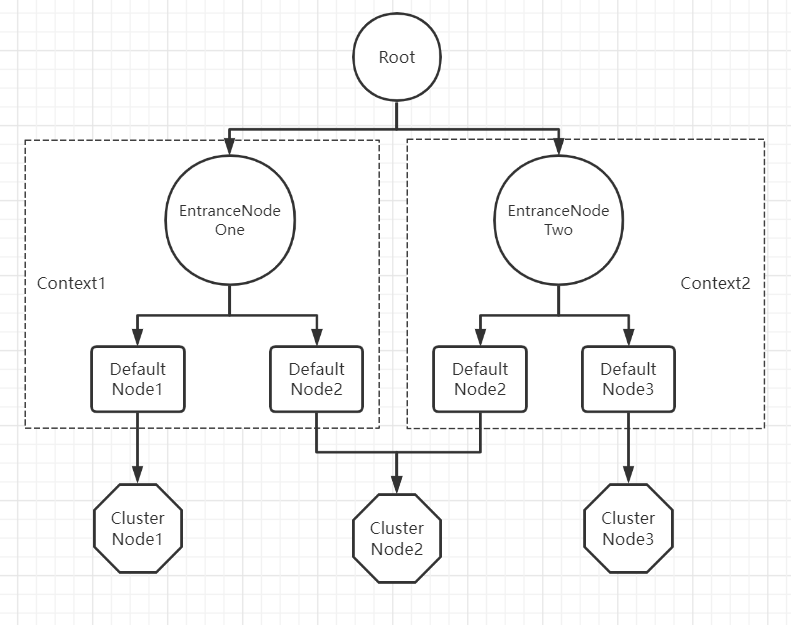一个Context之中,Resource和Entry的关系,一个Context中可以有多个Resource,每个资源都必须都应一个Entry。
Node 关系官方图解
这张图的上班部分其实体现了Node之间的关系,官方提供的图不够明显,我们需要进行细化

要先理解这个官方提供的图,我们需要看一下源码的关系

从这张图片我们能够提取出几个Node:
- Node:接口,Sentinel 里面的各种种类的统计节点
- StatisticNode:统计节点,是Node的实现类,用于完成数据统计
- EntranceNode:DefaultNode的子类,入口节点,一个Context会有一个入口节点,用于统计当前Context的总体流量数据,统计维度为Context
- DefaultNode:默认节点,用于统计一个resource在当前Context中的流量数据,DefaultNode持有指定的Context和指定的Resource的统计数据,意味着DefaultNode是以Context和Resource为维度的统计节点
- ClusterNode:ClusterNode保存的是同一个Resource的相关的统计信息,是以Resource为维度的,不区分Context,这个是和DefaultNode的区别
Node之间的关系
Node 接口定义了一个 Node 类所需要提供的各项指标数据统计的相关功能,为外部屏蔽滑动窗口的存在。提供记录请求被拒绝、请求被放行、请求处理异常、请求处理成功的方法,以及获取当前时间窗口统计的请求总数、平均耗时等方法。

案例代码改进
昨天我们通过官方提供的演示案例写一个演示代码,那么我们为了理解这个Node之间的关系,我们再来增加一些代码,为了理解Node之间的关系
1
2
3
4
5
6
7
8
9
10
11
12
13
14
15
16
17
18
19
20
21
22
23
24
25
26
27
28
29
30
31
32
33
34
35
36
37
38
39
40
41
42
43
44
45
46
47
48
49
50
51
52
53
54
55
56
57
58
59
60
61
62
63
|
package demo;
import com.alibaba.csp.sentinel.Entry;
import com.alibaba.csp.sentinel.Sph;
import com.alibaba.csp.sentinel.SphU;
import com.alibaba.csp.sentinel.context.ContextUtil;
import com.alibaba.csp.sentinel.slots.block.BlockException;
public class ContextDemo {
public void ContextUtil(){
ContextUtil.enter("entrance1", "appA");
Entry nodeA = null;
Entry nodeB = null;
try {
nodeA = SphU.entry("resource1");
nodeB = SphU.entry("resource2");
} catch (BlockException e) {
e.printStackTrace();
} finally {
if (nodeA != null) {
nodeA.exit();
}
if (nodeB != null) {
nodeB.exit();
}
}
ContextUtil.exit();
ContextUtil.enter("entrance2", "appA");
Entry nodeC = null;
try {
nodeB = SphU.entry("resource2");
nodeC = SphU.entry("resource3");
} catch (BlockException e) {
e.printStackTrace();
} finally {
if (nodeB != null) {
nodeB.exit();
}
if (nodeC != null) {
nodeC.exit();
}
}
ContextUtil.exit();
}
}
|


